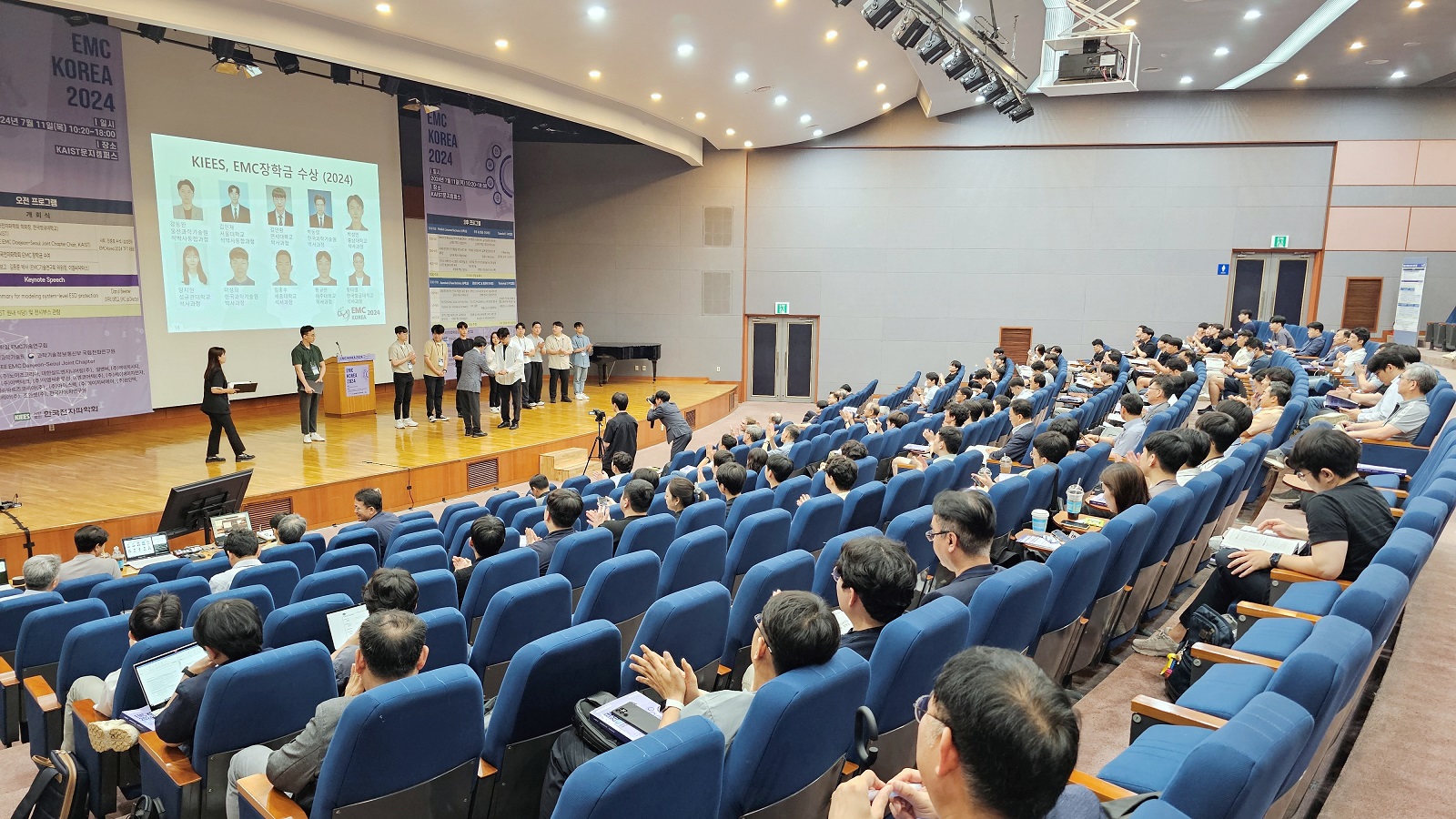모든 전자제품의 주요 기반 기술로 EMI/EMC가 필수이며, 최근 자동차의 전동화와 각종 IT 디바이스의 소형화, 5G·6G 통신으로의 패러다임 전환 등으로 전자파 환경에서의 노이즈가 증가하면서 EMI/EMC 필요성은 더욱 부각되고 있는 실정이다.

▲기사 내용과 무관. EMC KOREA 2024에서 국내 EMC 분야를 연구하는 석학들에게 장학금 수여가 진행되고 있는 모습.
KAIST, 반도체 SI/PI 연구실적 두각
UNIST, EMIC 실물 하드웨어 강점
연세대, 수치해석 강점 국방 특성화
성균관대, 차세대 모빌리티 협력↑
모든 전자제품의 주요 기반 기술로 EMI/EMC가 필수이며, 최근 자동차의 전동화와 각종 IT 디바이스의 소형화, 5G·6G 통신으로의 패러다임 전환 등으로 전자파 환경에서의 노이즈가 증가하면서 EMI/EMC 필요성은 더욱 부각되고 있는 실정이다.
첨단 산업을 발전시키기 위한 인재 양성에 대한 중요성이 커지고 있는 상황에서 국내 주요 대학 EMC 연구실을 살펴봤다.
■ KAIST EMC 연구실
한국과학기술원(KAIST)에 있는 EMC 연구실은 안승영 교수가 지도교수로 있으며, KAIST 조천식모빌리티대학원와 전기전자공학부 겸임교수로도 활동하고 있다. 안 교수는 전기차 무선전력전송기술 및 고속디지털시스템 신호무결성 설계의 전문가로 IEEE EMC Society의 서울-대전 지부장을 맡고 있다.
KAIST EMC 연구실은 EMC와 SI/PI를 비롯해 무선전력전송 분야를 타켓하고 있으며, EMC 영역에서 △EMF 인체 노출 분석 △EMC 소음 분석 △EMC 구성 요소 측정 및 모델링 △AI 기반 EMC 설계 및 분석 등의 연구를 수행하고 있다.
최근 반도체 고집적화와 미세화를 비롯해 칩-칩, 칩-통신 데이터 전송이 고속화됨에 따라 반도체 SI/PI 최적화가 크게 각광받고 있다.
이에 KAIST EMC 연구실에서도 최근 진행 중인 연구에서 △Interposer 유전체 및 전극 구조 특성에 따른 Signal Integrity 값 계산(삼성전자) △Signal and Power Integrity with Machine Learning(삼성전자) △반도체, 패키지, 모듈의 성능과 신뢰성 향상을 위한 5I(SI, PI, TI, EMI, AI)에 관한 연구(SK하이닉스) △Advanced PSI Technology for Chiplet Implementation(삼성전자) 등 반도체 관련 SI/PI 연구가 다수 수행되고 있다.
■ UNIST IC&EMC 융합 연구실
김진국 교수가 이끌고 있는 울산과학기술원(UNIST)의 IC&EMC 융합 연구실은 반도체 회로와 전자기파라는 두 가지 분야의 융합 연구를 주로 수행하며, EMI/EMC를 위한 반도체 회로, 패키지, 시스템 설계에 연구 분야에 강점이 있다.
IC&EMC 융합 연구실이 개발한 EMI/EMC IC에는 △웨이퍼 레벨 패키지의 EMI 분석용 IC △EMIC(Electromagnetic Interference Management IC) △오실로스코프 IC △능동 EMI 필터 IC △ESD 노이즈 영향 분석·측정용 IC 2종 △SI/PI 분석용 IC 3종이 있다.
이곳의 차별화되는 특성이 바로 실물 칩을 제작하는 등 하드웨어적 강점에 있으며, 김진국 교수가 공동 대표로 있는 연구소 기반 설립 회사인 이엠코어텍을 2018년 설립해 EMIC 및 맞춤형 모듈, EMI 솔루션과 EMI 센싱 등의 제품을 시장에 선보이고 있다.
주요 프로젝트에는 △EMC △SI/PI △EMI/EMC를 위한 반도체 설계 △반도체 패키지 설계 △인공지능 기반 EMC 디자인 등이다. 최근 수행 중인 연구로는 △시스템 레벨 ESD 노이즈 분석 및 내성 개선 연구(SK하이닉스) △고전압 모터시스템 전자파 노이즈 저감 위한 능동 초크 회로 개발(현대자동차) △반도체, 패키지, 모듈의 성능과 신뢰성 향상을 위한 5I(SI, PI, TI, EMI, AI)에 관한 연구(SK하이닉스) 등을 현재 수행하고 있다.
■ 연세대 ACEM 연구실
육종관 교수가 맡고 있는 연세대 ACEM 연구실은 ‘첨단계산전자기학(Advanced Computational Electromagnetics)’ 분야를 연구하는 곳으로, 시너지 효과를 내는 4개 연구 분야를 결합했다.
△RF 시스템 △수치해석 △통신 △EMI/EMC 분야를 아우르며, △수치해석 기법을 이용한 전투기의 RCS 분석 △플라즈마를 이용한 RCS 저감 연구 △EMP에 의한 드론에 유기되는 커플링 현상 분석 △보안 및 신호 복원을 위한 TEMPEST 등의 연구를 수행한다.
ACEM 연구실의 특징은 △국가보안기술연구소 △국방과학기술진흥연구소 △국방과학연구소 등과의 정부연구과제를 비롯해 △안티드론 발전 방향 및 함정 적용방안 연구(한화오션) △고이득레이돔 구조에 의한 성능 개선 방안에 관한 연구(LIG넥스원) 등 국방·방산 부분 연구 실적에 있다.
지도교수인 육종관 교수는 전자파 수치해석 분야 국내 최고 전문가로 국방 및 보안 분야에서 두각을 나타내고 있다. 이에 특화 연구실로 △항공 피탐지 감소기술 연구실 △스텔스 대형 플랫폼 전파해석 특화 연구실을 산하에 두고 있다.
■ 성균관대 EMC 연구실
성균관대 EMC 연구실은 나완수 교수가 지도교수로 이끌고 있으며, 칩-패키지-PCB-하이브리드 차량 시스템 수준에서의 SI/PI 및 EMI/EMC 문제에 효율적인 솔루션을 제공하는 것을 목표로 하고 있다.
나완수 교수는 △칩-패키지-PCB SI/PI/EMC △집적 회로 및 차량용 EMI/EMS △전자 패키징을 위한 고주파 특성 △고속 디지털 시스템 설계 등에서 연구를 이어오고 있으며, 1995년부터 성균관대 EMC 연구실을 설립해 국내외 EMC 석학들을 양성하고 있다.
최근 연구 성과에서 △Flex PCB 부품의 RF 내성 평가를 위한 ground 분리 구조의 noise inejctor 개발 △광대역 복사 방해 전자파를 이용한 전자기기의 전자파 내성 분석 모델 개발에 대한 연구 △FET 고주파 해석 모델링 기법 개발 등 국내 대기업들과의 연구과제 수행 실적을 내고 있다.
특히 최근 5년 간은 전기차, 스마트카 등의 차세대 모빌리티가 주목받으면서 나 교수는 △만도 △삼원액트 △LS오토모티브테크놀로지스 △현대NGV 등과 함께 차세대 모빌리티 전장품 기술 개발에 협력하기도 했다.
